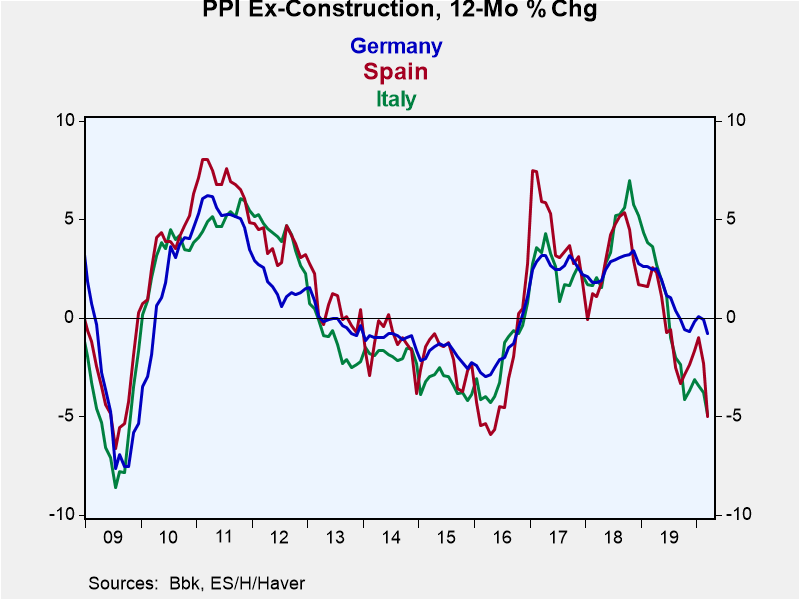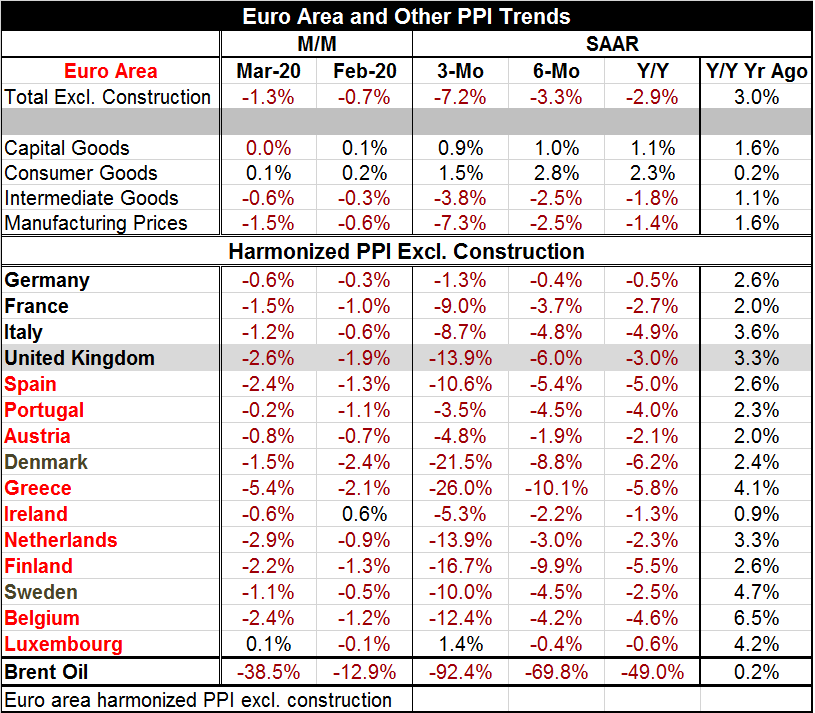 Global| May 05 2020
Global| May 05 2020EMU PPI Weakens Sharply; Impacts of COVID-19 and the Fight Against It Spread Everywhere
Summary
I read the news today, oh, boy… It is Cinco de Mayo but the bars are closed so celebrating that holds bleak prospects. The euro area PPI is not the sort of thing we would celebrate, putting Cinco de Mayo aside. Sure, low-inflation [...]
 I read the news today, oh, boy… It is Cinco de Mayo but the bars are closed so celebrating that holds bleak prospects. The euro area PPI is not the sort of thing we would celebrate, putting Cinco de Mayo aside. Sure, low-inflation lovers might cozy-up to the weak reading for a while, but the clear message from prices this weak is that underlying activity is not doing well. The last time PPI prices were weak like this was in 2016 when growth had slowed and previous to that we are looking down the barrel of the Great Recession. As Clint Eastwood playing inspector Harry Callahan once asked, "Do you feel lucky…?"
I read the news today, oh, boy… It is Cinco de Mayo but the bars are closed so celebrating that holds bleak prospects. The euro area PPI is not the sort of thing we would celebrate, putting Cinco de Mayo aside. Sure, low-inflation lovers might cozy-up to the weak reading for a while, but the clear message from prices this weak is that underlying activity is not doing well. The last time PPI prices were weak like this was in 2016 when growth had slowed and previous to that we are looking down the barrel of the Great Recession. As Clint Eastwood playing inspector Harry Callahan once asked, "Do you feel lucky…?"
Absent luck, weakness of this magnitude across the entire euro area is a clear-cut bad signal for growth. In fact, two of three main sectors capital goods and intermediate goods show prices decelerating from one year to six-months to three-months. For manufactured goods, the progression is most severe. For capital goods, the downward progression is only technical in nature, at least so far. Consumer goods also are working their way to smaller increases, but their progress shows a slight detour to faster growth over six months before slowing more sharply over three months. But the slowing message is loud and clear.
PPI deflation is more virulent than the coronavirus
Across the 15 countries in the table, most of whom are EMU members, over three months inflation is lower than over six months for 13 of them, for 10 of them inflation is lower over six months than over 12 months. For all 15 of them, inflation is lower over 12 months than it was 12-months ago. Of course, on these same periods Brent oil prices also are locked in a progression of ever faster declines. Some of this is oil per se. But oil prices are weak because of excess supply, cartel control issues and plunging demand and growth on the back of weakness created from fighting the coronavirus… so taking out oil as an explanation is not sensible.

Corona effects are everywhere
The impact of the Corona virus is everywhere. Spanish unemployment rose in a report issued today. Also today U.K. car sales showed record weakness as the U.K. services sector exhibited severe weakness itself. In Asia, there was severe weakness in the Aussie services sector and a sharp fall in Singapore's retail sales as well as ongoing weakness in Hong Kong's retail sales. Weakness is the theme promoted by fighting corona.
A report in China has warned of a global backlash from the virus that was spawned there. Firms in the U.S. and elsewhere, already seem to be planning, or acting, to reduce supply-chain reliance on China.
Did Mother Nature finally strike back at China?
In truth, it is not just this virus that China is trying to contain. The Chinese people have been unhappy with their government's defilement of the environment for some time. Pollution across China has been terrible for a very long time. Beijing's pollution has been so bad that for at least the last 20 years visitors going there have been urged not to run outside. This is not China's first outbreak of disease. There previously was SARS. More recently China had an outbreak of a disease that killed animals, (H5N1) killed chickens. Apparently there was this year a new H5N1 outbreak as well and as 18,000 chickens were slaughtered around February (Source). Recently a separate outbreak over this past year caused China to slaughter most of its hog population (Source). Swine flu caused China's pig population to drop by 40% by the end of August 2019! More than one-quarter of the world's pigs were killed to stop the spread of that disease. China's treatment of its environment and food supply has been nothing short of deplorable. While there are some ‘new' and so far unfounded accusations that the Chinese virus may have come from a laboratory doing research in China, the deplorable state of China's outside live food market and its overall neglect of food sanitation and abuse of the environment simply give China rich opportunities to have incubated the virus ‘naturally.'
Trump-Pompeo allegations
I have no idea where the Trump-Pompeo allegations are going. Nor do I know if they have substance or if they piggyback mostly on reports of China covering up and stopping any attempt by anyone including its citizens to look further into the cause of the virus. A new report from France now finds a man who is the earliest infected person there, who had the disease on December 27. Apparently he had contracted it before Christmas given the incubation period. WHO has encouraged countries to look into any hint of earlier infections and claims to be not surprised by the French finding. This leads me to wonder what WHO may know.
Hide under a rock
Nothing about the approach to the virus seems right to me. The numbers of the dead are large, but it is a big world with a large population and the thing that seems to distinguish this virus most of all is its ability to spread along with its stealth capabilities. Increasingly, new evidence shows that infection rates are higher than suspected a result that reduces morbidity rates. For NYC, among healthy people the morbidity rate is extremely small. For the population overall in NY, the morbidity rate seems to be 0.7%. Yet, WHO refers to the virus as one of the greatest challenges it has faced. We know the disease is good at killing those who already have a key batch of maladies. The clear smart targeted thing to do to ‘flatten the curve' would be to SHELTER THOSE PEOPLE – not everyone. Yet, this not the plan and I do not see any emphasis (mention yes but nothing to drive it home; no emphasis) on protecting the groups we know to be most at risk. Why? At least one doctor (here) is upset by the prohibition in some states about the use of safe, known, medicines in an off-label angle to fight COVID-19.
The COVID-19 bias
Whatever is going on, the direct damage from this virus does not seem in any way worth the sort of punishment that we are inflicting on ourselves through the shelter-all-in-place protocol. In NYC, only 1.4% of the deaths are among people with no known medical preconditions. That translates to a morbidity rate that is extremely small around 0.1%. And because doctors are counting deaths as COVID-19 even if a patient has other diseases present, diseases that might even be acute, deaths are being over-allocated to COVID-19.
Real science
I can't say what the next step will be. All countries are trying to move forward. I know in the U.S. the argument to open or to not open divides us nationally along party lines – and, in truth, that does not make any sense. But there are things we can do and that we know about this disease that have an important bearing on the decision to open or not. And we do not seem to be using any of that as leverage to deal with this disease. We have scientists urging us to stay home and wait for a vaccine to be developed. But that is not science! Real science knows that one can never count on a vaccine being developed in six months, 18 months or ever –ever! How long have we sought to cure cancer? As an economist, a social scientist myself I cannot understand the logic of what is being done here…There is no science as far as I can tell. There is politics.
The pixie dust problem
Europe is gradually opening. In the U.S., some states are opening. Some disease specialists are projecting a new outbreak in the U.S. because of this. We hear how a nation needs herd immunity to stop a second wave (about a 60% infection rate) but in eh U.S. citizens are taking action to prevent that from happening by distancing. Then because there is no herd immunity there is fear a second wave, maybe in September. I am concerned about what scientists think beyond having us wait until someone can sprinkle pixie dust over us all. And then I wonder how long that will take… if pixie dust is ever developed at all? How is waiting on pixie dust (vaccine) science? And is the U.S. not supposed to follow the lead of other countries and gradually open back up? What kind of new world is it that scientists see? Who will pay their bills in this world? Who will buy their machines and medicines if no one is working? How can fearing the fate of 0.7% of the population coupled with failure to make those numbers lower by protecting our must vulnerable citizens grounds for living under a rock?
European economies are going to be an important marker for what is possible or what is risky. There are a number of countries pressing different angles for recovery. In Asia, Singapore is getting ready to go back to work. All of these moves have risk. Each locality has its own plan. Living under a rock is not one of them anywhere else in the world.
Robert Brusca
AuthorMore in Author Profile »Robert A. Brusca is Chief Economist of Fact and Opinion Economics, a consulting firm he founded in Manhattan. He has been an economist on Wall Street for over 25 years. He has visited central banking and large institutional clients in over 30 countries in his career as an economist. Mr. Brusca was a Divisional Research Chief at the Federal Reserve Bank of NY (Chief of the International Financial markets Division), a Fed Watcher at Irving Trust and Chief Economist at Nikko Securities International. He is widely quoted and appears in various media. Mr. Brusca holds an MA and Ph.D. in economics from Michigan State University and a BA in Economics from the University of Michigan. His research pursues his strong interests in non aligned policy economics as well as international economics. FAO Economics’ research targets investors to assist them in making better investment decisions in stocks, bonds and in a variety of international assets. The company does not manage money and has no conflicts in giving economic advice.






